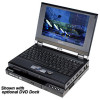Toshiba U100-S213 User Guide - Page 195
Memory problems
 |
View all Toshiba U100-S213 manuals
Add to My Manuals
Save this manual to your list of manuals |
Page 195 highlights
195 If Something Goes Wrong Resolving a hardware conflict ❖ The Resource tab, which lists resources assigned to the monitor, optional external DVD-ROM, optional external diskette drive, and other power-using functions. This tab does not appear if the device is not using resources. ❖ The Driver tab, which displays the drivers being used by the device. The tabs that appear in the dialog box vary from one device to another. A Troubleshooting button is also present. 4 Click Troubleshoot... A Help and Support window for that device appears. For more information about Device Manager, refer to Windows® XP online help. Memory problems Incorrectly connected or faulty memory modules may cause errors that seem to be device-related. It is worthwhile checking for these first: 1 Click Start, Turn off computer. 2 Click Turn Off. The operating system shuts down and turns off the computer automatically. 3 Remove the memory module, following the instructions in "Removing a memory module" on page 52. 4 Reinstall the memory module, following the instructions in "Installing a memory module" on page 49, making sure the module is seated properly.















